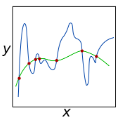Learning representations of nodes has been a crucial area of the graph machine learning research area. A well-defined node embedding model should reflect both node features and the graph structure in the final embedding. In the case of dynamic graphs, this problem becomes even more complex as both features and structure may change over time. The embeddings of particular nodes should remain comparable during the evolution of the graph, what can be achieved by applying an alignment procedure. This step was often applied in existing works after the node embedding was already computed. In this paper, we introduce a framework -- RAFEN -- that allows to enrich any existing node embedding method using the aforementioned alignment term and learning aligned node embedding during training time. We propose several variants of our framework and demonstrate its performance on six real-world datasets. RAFEN achieves on-par or better performance than existing approaches without requiring additional processing steps.
翻译:学习节点表示一直是图机器学习研究领域的关键问题。一个良好定义的节点嵌入模型应该在最终的嵌入中反映出节点特征和图结构。在动态图的情况下,这个问题变得更加复杂,因为特征和结构在演化过程中都可能发生变化。特定节点的嵌入应在图的演化过程中保持可比性,这可以通过应用对齐过程来实现。现有研究中通常是在计算出节点嵌入之后才应用对齐。在本文中,我们引入一个名为RAFEN的框架,它允许在训练过程中使用上述对齐项来丰富任何现有节点嵌入方法,并学习对齐的节点嵌入。我们提出了我们框架的几个变体,并在六个真实世界的数据集上展示了其性能。RAFEN实现了与现有方法相当或更好的性能,而无需额外的处理步骤。



